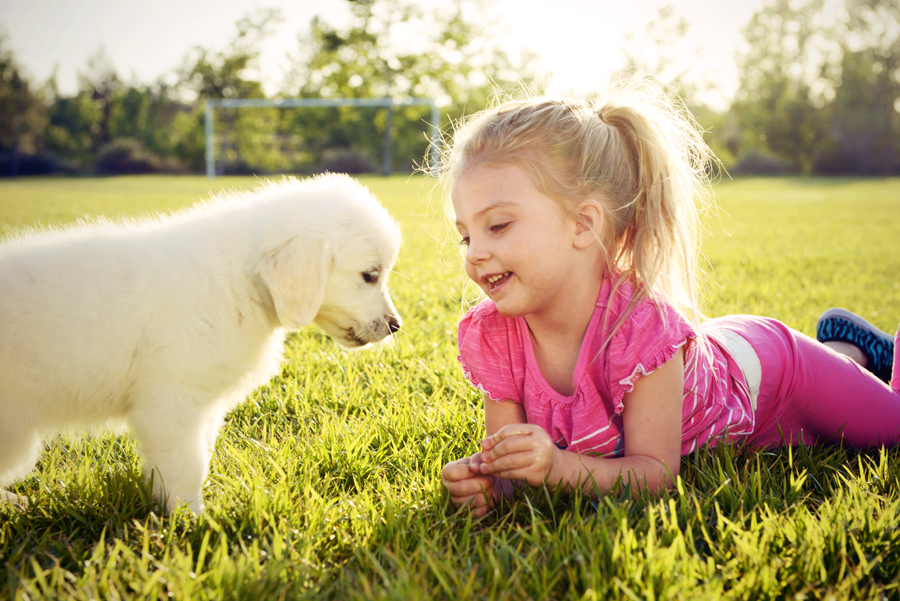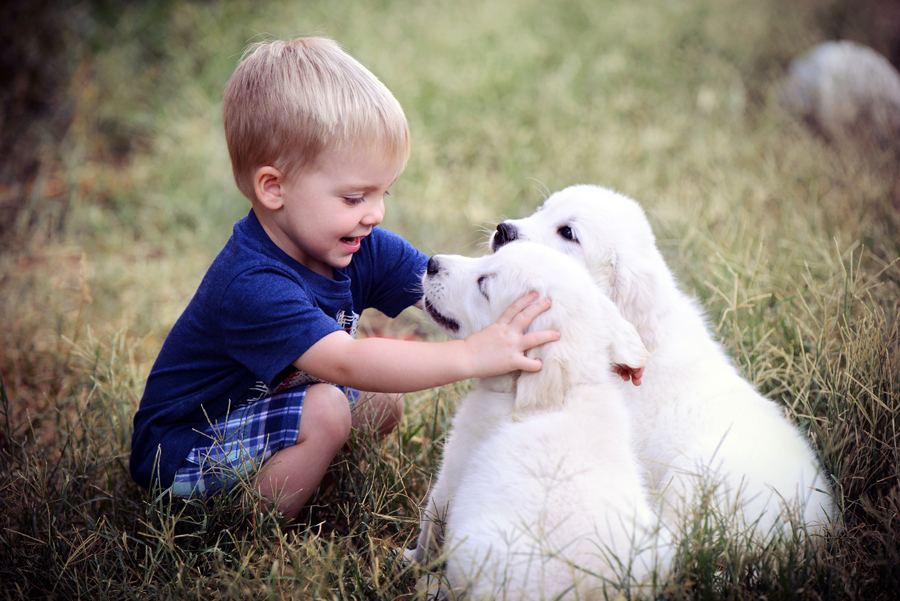The bond between puppies and kids is a special one. The playful energy of a puppy and the carefree spirit of a child make for a perfect match. However, introducing a puppy into a household with children requires careful consideration and planning. In this article, we will discuss tips for creating a successful relationship between puppies and kids.

Johanna smiling at Alice
Find the Right Pup
First and foremost, it is essential to choose the right breed of puppy for your household. While all puppies are cute, some breeds are better suited for families with young children. According to the American Kennel Club, breeds such as the Golden Retriever, Labrador Retriever, and Bulldog are excellent choices for families with kids. These breeds are known for their friendly, patient, and gentle nature. As a Golden Retriever breeder, we are partial to goldens. We’ve had multiple pups grow up with both our daughter and our son. Alice grew up with Johanna, and Glacier and Jaks grew up with Braeden.
Additionally, it is important to adopt a puppy that is at least eight weeks old. Puppies younger than eight weeks have not yet developed the necessary social skills to interact with children. It is also crucial to choose a puppy that has been well-socialized with people and other animals. If you choose a younger pup, then the pup will think your child is its litter mate, and learn to chew and bite on them. They need to learn their limits with their own littermates first.
Prepare Your Home
Once you have chosen the right puppy, it is essential to prepare your home for their arrival. Puppies, like children, are curious and like to explore their surroundings. Therefore, it is important to puppy-proof your home by removing any hazardous items that the puppy could chew or swallow. This includes small toys, electrical cords, and toxic substances such as cleaning products. I wrote an article on this subject: Setting Up Your Home for Your Golden Retriever Puppy.
It is also important to establish boundaries for the puppy. Puppies need to learn what areas of the house are off-limits, such as bedrooms or bathrooms. This can be achieved by using baby gates or closing doors.
Introduction With Your Child
When introducing a puppy to children, it is important to supervise their interactions. Children can be unpredictable, and puppies may not understand boundaries. Therefore, it is essential to teach children how to interact with puppies gently and respectfully. Children should be taught to avoid pulling the puppy’s tail or ears, and to avoid roughhousing with the puppy.
It is also important to teach children to approach the puppy calmly and to avoid overwhelming the puppy with too much attention. Puppies need plenty of rest, and children should be taught to recognize when the puppy needs space. Let them know the boundaries before the puppy comes home.
Another important aspect of introducing a puppy to children is teaching children to recognize signs of aggression or fear in the puppy. Children should be taught to recognize when the puppy is uncomfortable and to give the puppy space. This includes recognizing signs such as growling or barking, and avoiding approaching the puppy when it is eating or sleeping. This is one of the most important pieces of advice I can offer. Having your child near a puppy and its food can lead to the most unwanted circumstances and hospital visits.
Training
Training is an essential part of a puppy’s development, and it is important to involve children in the training process. Children can help with basic commands such as sit, stay, and come. Involving children in the training process can help to strengthen the bond between the puppy and the child. Plus we all know that training isn’t just for the pup, but also to train the pup’s owner.
It is also important to establish a routine for the puppy. Puppies thrive on routine, and a consistent schedule can help to prevent behavioral problems. Children can help with feeding and walking the puppy, which can help to reinforce the bond between the puppy and the child. Just as word of caution again, be careful with feeding.
Finally, it is important to remember that owning a puppy is a big responsibility. Children should be taught to take responsibility for their pet by helping with feeding, walking, and grooming. This can help to instill a sense of responsibility and empathy in children, which can be beneficial in other areas of their lives.
Summary
Introducing a puppy to a household with children requires careful consideration and planning. It is important to choose the right breed of puppy (hopefully a Golden Retriever Puppy), prepare your home for their arrival, and establish boundaries for the puppy. When introducing a puppy to children, it is essential to supervise their interactions and teach children to interact with puppies gently and respectfully. Involving children in the training process and establishing a routine for the puppy can help to strengthen the bond between the puppy and the child. Owning a puppy is a big responsibility, and children should be taught to take responsibility for their pet by helping with feeding, walking, and grooming.
The relationship between puppies and kids can be a beautiful one. Puppies can teach children empathy, responsibility, and unconditional love. However, it is important to remember that owning a puppy is a big responsibility and requires careful consideration and planning. By following these tips, you can create a successful relationship between puppies and kids, and provide a loving home for your furry friend.
Both my male Golden Retrievers have been awesome with my children. They are calm with them, visa versa. They now get to grow up together for many more years to come.

Braeden and two Golden Retriever Puppies
Sources:
- American Kennel Club. (2021). Best dog breeds for kids. Retrieved from https://www.akc.org/expert-advice/lifestyle/best-dog-breeds-for-kids/
- ASPCA. (2021). Introducing your puppy to children. Retrieved from https://www.aspca.org/pet-care/dog-care/common-dog-behavior-issues/introducing-your-puppy-children
- Purina. (2021). How to introduce your puppy to children. Retrieved from https://www.purina.co.uk/articles/puppy/training/how-to-introduce-your-puppy-to-children
- Vetstreet. (2021). Puppies and kids: A match made in heaven? Retrieved from https://www.vetstreet.com/our-pet-experts/puppies-and-kids-a-match-made-in-heaven


Leave a Reply